Jimmie Robinson can do basically anything. Writer, artist, designer and letterer, his most recent work Five Weapons has been receiving great acclaim from fans and critics alike. Set in a school for young would-be-assassins, the series sees the weaponless Tyler Shainline come to school and find himself immediately ducking and diving from the attentions of the various cliques. Only, rather than this being a ‘jocks’ or ‘goths’ or ‘whatever Molly Ringwald’s group affiliation was in Breakfast Club’-type situation, the different cliques here are all loyal to their own preferred deadly weapon. Knives, clubs, ‘alternative weapons’… Five Weapons has the lot. And two others!
It’s also a return to all-ages comics for Robinson, who is most well known for his tongue-in-cheek series Bomb Queen, also published for Image. And as all-ages comics are THE BEST COMICS EVER, I was determined to speak with him about the miniseries, which will – as the title suggests – be five issues long. Jimmie was kind enough to answer some questions about freelance life – creating Five Weapons, organising a creator-owned miniseries, and how he approaches a story. It’s a must-read interview from a creator who is on blistering form right now.
Steve: Where did the original idea for Five Weapons come from? Was this a story you’ve had in mind for a while?
Jimmie: I had this for a long time. It didn’t come as a flash of lightening. It was more like a series of base hits until I could make it to home plate. However, the germ of the story came from an old myth that I heard about a long time ago. It’s about one of the incarnations of the Buddha. The story is aptly named Prince Five Weapons. The basic fable is that a prince goes off to train under a master to learn the arts of the five deadliest weapons. After he did that, he began traveling back home. In the forest he encounters a monster called Sticky Hair. The Prince uses all five of his newly mastered weapons and nothing happens. Then the Prince tells the monster that it doesn’t matter because he has an invisible sixth weapon that the monster cannot beat. The monster believes this and sets him free. Whether that is read with a spiritual slant or just as a form of trickery, the point is that the prince did not win until he resorted to the skill and belief of his mind – not his weapons.
I heard that about ten years ago, but it was last year when I started working on how to incorporate that into a comic book structure. The look and style of the story and art went through several phases, from gritty realism to something slightly cartoony. But once I saw how I wanted it to work as a whole, I broke it down into the story we see today – which took even more work to get it down to a 22-page format.
I also took it to some of my peers. There is a professional forum where a number of folks get together and talk shop. We keep involvement at a minimum for obvious legal reasons. It’s more for support than anything else. It’s not open to the public, per se, but pros in the industry can access it. Inside the forum they have private “work blogs” where it is eyes-only on art, WIP, scripts, rants & raves, etc. After raising Five Weapons on my own, I decided to show it around to my peers and get some feedback. But what I ended up with looks nothing like where it started.
Steve: Was this always something you felt would work as a mini-series, rather than an on-going story?
Jimmie: Yes, I wanted to tell a specific story with a specific outcome and I wanted it served up quickly with a punch. I want the reader to not put it down until they hit the end. The beats, the rhythm, the flow and the story all have a job to do and deliver the package fully by the end.
This is seen even in the layout and design. You might notice that all the panels are horizontal. I didn’t want the reader’s eye to jump all over the page. Even the word balloons flow down to the next panel when I’m connecting them. In my view, this is all part of the mini-series concept. It’s a quick and hard hit. It’s not a decompressed structure so there’s no need to waste time and space. So yes, I saw this working as a mini-series because I didn’t want to dilute the goal and theme of the story.
Lastly, it’s also a way to get in and get out if things go bad. To be honest, I had no idea if Five Weapons would even work in today’s market. I have almost 30 issues of Bomb Queen under my belt and there are some readers who only know me as ‘that Bomb guy.’ The mini-series allows me to gently break free from that and try new things.
Jim Valentino’s publishing arm at Shadowline is also built for the mini-series format. He has some on-going titles, but Valentino likes to try new things and search for new ideas in comics – beyond superheroes. He has done that since the 1990’s when he launched his “Non-Line” at Image Comics when he was President. He’s an indie guy at heart.
Steve: When writing a miniseries rather than a one-shot or on-going, I imagine you have to process the narrative very differently – it has to go on for several issues, but it also needs to come to a satisfying conclusion in the final issue. So… how do you start with a story like Five Weapons? Where do you start?
Jimmie: For Five Weapons, I had to think about my process in a different manner than I did for Bomb Queen. Before it was a matter of writing story arcs. I simply had to find the appropriate place to end off and continue the story in the next issue. However, with Five Weapons, I needed to end each issue with a cliff hanger that would be resolved in the next issue, not at the end of the entire arc. So starting out, I knew I had to tie five cliff hangers into a story that led to an ultimate conclusion. This is how most of the old pulp comics were written. You aim to leave off at dramatic point of conflict in a do-or-die situation.
For each issue the true starting point is asking the question: HOW can a guy with no weapon fight a master of knives, staves, archery, guns or exotic weapons? Once I know the weakness of a weapon, I can spin that around the characters, then spin that into a story in the school, then spin that into a 22-page format, and then seed that into the entire story arc. I can tell you it has challenged me. Some weapons are just hard to beat. I had to come up with some odd solutions, but in a way that helped the story because zany ideas and solutions worked in a zany school. I’m not trying to create realism. There’s nothing funny at all about kids with guns. But, from my childhood, there was a lot of fun found in absurd violence, such as Looney Tunes, Popeye, and Tom & Jerry. I’m not aiming for gag comedy or physical slapstick, but I wanted to find a zone where it was okay to use it as a story element.
Steve: Do you think you can view each issue as a standalone story within a bigger narrative, or do you look at the entire story as a single collected piece, spread out over several months?
Jimmie: It’s a single piece. I want readers to be out of breath when they hit the end. When I created Five Weapons I was thinking heavily about the physical comic and even about the digital format. That’s another reason why the panels are all horizontal. The reader can simply scroll down instead of left-to-right-then-down and repeat. In fact, you could put this back-to-back and line all the story pages together as one huge piece and it would run like a clock without skipping a beat.
Steve: When you’re in the planning stages for a mini-series like this, how do you decide how many issues would be ideal for a story? Do you look to compress six issues of story into five issues, or expand four issues into five?
Jimmie: I had to compress six issues into five. I wanted more, but honestly I had no idea if the book would work or not. I didn’t want to be in a situation where I had to decide to cancel it before the end. Even a book that’s slated for 6, 7 or 8 issues can be a challenge if it doesn’t catch on.
At first I did want 6 issues, because I knew I had to deal with each weapon club, plus a cliff hanger in every issue and still finish the larger story that ties them together. So I really had to put on my thinking cap and figure out how to compress the story and stress some word economy. Trust me, it’s harder to say the right thing in the least amount of words than to just get to the point by rambling on around the bush. I’m notorious for what they call “burying the headline.”
Steve: Five Weapons = five issues. Once the first issue came out, the following four could’ve followed the same formula and still made for a fun series. However, the story doesn’t feature a different weapon each issue – instead, scenes stretch over multiple issues, and conflicts build and burst at unexpected moments. How important do you think it is for a story to surprise readers?
Jimmie: I had to do that because, as noted earlier, I couldn’t do exactly five issues and still get everything done. But that also played in my favor because it prevents the events from looking like a cookie cutter plot. A few friends sent me links to reviews where the reviewer said the story looks like it’ll follow the same formula. It made me smile because I know it won’t. There is a distinct beginning, middle and end — which obviously can’t be the same from A to Z.
And you’re right that it is important to surprise the readers in a mini-series like this, which involves mystery and slight of hand. I’m constantly thinking how to shift the pieces on the board, but at the same time I don’t want to alienate readers with something so out there that they won’t understand. For instance let’s look at issue #2, which is out now. Some folks have said they can see how the lead character will beat the stick weapon. I even added emphasis to a keyword in the dialoge. That’s okay. I’m giving the reader a way to connect, but I’m keeping exactly how I will execute that to myself. That’s the surprise, much like a game of chess when you sacrifice a pawn just to use another piece hidden in plain sight.
Steve: What are the most difficult parts of putting together a mini-series? Were there any characters you wanted to feature more fully, or scenes you had to cut down?
Jimmie: I had to cut it down a lot. I had a ton of flashback scenes, some world building, the rivalry between the faculty, the backstory between the principal and the school nurse, and some of the education and classwork. One of the things that irk me when I see a story based in a school is the lack of seeing students doing actual schoolwork. It’s as if the students spend 100% of their time in the hallway, the cafeteria or sitting on the bleachers. Sadly, I’ve fallen into that same trap because of the mini-series format. Otherwise, I would show details of students working math, science, and English. Often those classes can flesh out a character. We see how they solve problems. How they handle frustration. How they stress at being the teacher’s pet. Unfortunately, I didn’t have enough pages to jump into that side of the sandbox.
Steve: How difficult is it to find a concluding event for each issue, especially once halfway through the story? The first issue can act as opening pitch, the final issue act as conclusion – but what is the key to making the middle chapters as involving?
Jimmie: I consider this a lot. Not just as a storyteller, but also as a businessman. Sales and order numbers tend to slip right after issue #1 and definitely in the middle of a series or a story arc. In the case of Five Weapons, compressing the story actually helped because in order to fight the five clubs I had to double up on issue #3 and #4. This raises the stakes very high at the end of #3 and hopefully keeps the readers on their toes. This also plays into avoiding the cookie cutter formula that some may fear. But keep in mind that a story like this, even with a lot of surprises, is also about expectations. We want certain people to win, others to lose and some to just step up their game. I want to keep things fresh, but on a commercial level I also have to keep things on track. Nobody wants to read a story that goes so far off the rails that you can’t figure out where it’s going.
When I write Five Weapons, my job is to lead the reader, not try and lose them in the dust. Sometimes that means playing to the reader’s expectations – however, the execution and twists are what really makes a story shine. It’s good to be innovative, and I hope in many ways I am doing that, but it’s even better to forge a new path that can still be recognized. In short, to do both!
Steve: One thing I was interested in asking was how writing, drawing, lettering your own story affects the creation process. If you’re trying to write a story to fit 22 pages, is there still room to give yourself splash pages, experiment with page layouts, and have fun with the art? Do you ever feel like you have to sacrifice writing for art, or vice versa?
Jimmie: I always sacrifice something since I’m not a master of one thing. I openly admit this. I’ve always done the chores of writing and drawing for all my books. I’ve done it since the 1990’s when I was self-publishing just to break into the industry. I’ve done it all through Bomb Queen. It does affect the creation process in one way or another. Often what happens is that I go over the entire process several times just trying to make it all come together as one package. You’d be surprised how often I don’t see the forest from the trees because my focus is elsewhere in the process. I write my scripts with full descriptions, yet I have no problem tossing it all out if I find a better mousetrap for the art, the story or a better line of dialogue. Then I paint myself deeper into a corner when that one new line of dialogue spurs a new direction in the story.
It can be rather dangerous when you build the boat that you sail yourself.
But that doesn’t mean I’m like a train without a track. I know where I’m going and how to get there. Sometimes I just find hidden gardens and secret paths that get me to the same place. This is also why I like my editor at Shadowline. Laura Tavishati is a real gem and she knows that I will take lines and rearrange them like a Rubik’s Cube. She can pull me back into reality when the dialogue sounds fine in my head, or even aloud, but not on the page. She doesn’t see my scripts ahead of time. She only sees the book in the last stage because I change so much in the script and on the page and even at the lettering stage. It would drive her crazy to edit a story only to find that I’ve changed it again, and again, until it gets to press.
Steve: On a similar note, how difficult do you find lettering over your own work? Do you have room to play around with the style, planning things out right from the start, during the scripting phase?
Jimmie: I hand-lettered my pages when I first got into comics, so I was raised on how to draw and leave space for word balloons. I usually sketch in where the balloons will be – especially when the balloon tails connect and lead the reader down the page. However, there are times when I still end up covering artwork with word balloons and it drives me crazy! I’ve been known to change entire blocks of text just to get the right balloon shape to fit on a panel so it would not block parts of the art. It’s nice having that option. However, it’s a dangerous route because it eats up time and it sucks to have a plan, execute it, and change it anyway.
Another example; my colorist, Paul Little, will send pages to me ready for lettering and I’ll see that he’s done some exceptionally cool highlight or detail and I don’t want to cover it up. Paul works hard and I’d hate to just slap stuff over it.
But after all this time I have a good grasp on what I can and cannot get away with. I’ve learned a lot of tricks about lettering and creating the illusion of space and breaking up segments of dialog to emphasize elements in the script. It’s actually quite fun. It’s like magic when it comes together.
An example would be in issue #3, when the school nurse confronts the principal and they take subtle jabs at each other in the dialogue. A good writer knows how to break up balloons for speech patterns and rhythm, but doing it with the art already in mind can bring it up a notch or two
Steve: What part of the creation process have you enjoyed the most on the book? Designing the artistic look of your world, writing the dialogue – what do you most look forward to?
Jimmie: I hate to say it, but I don’t have a favorite. I will admit to having a love / hate relationship with my art. I know I can do better. My style allows for some wiggle room so often my readers forgive my mistakes. I enjoy doing the art because I know all the cool scenes and camera angles, but I hate it when I can’t get what’s in my head on the paper. As for writing, I love when I can create the connective tissue that links everything together. I’m not as good with one-liners and dialogue as I’d like to be. My editor has caught plenty of mistakes when I slice-n-dice so many things together in my attempt to sound cool. I tend to write from the ear, which is often not grammatically correct. I love abusing commas. I tend to, punctuate, with them, a lot (that was a prime example). As for lettering, I like it because it is the navigator of the page. You can follow a page without lettering when it is drawn well, but a complex story works best when words and art are combined.
So, I don’t have a part I enjoy the most. I enjoy it all. Each stage is a challenge. I like to work on the book in phases. I will write the entire issue, then draw the entire issue, and then letter the entire issue. So it’s not like the various hats that I wear compete for attention. In fact, it feels odd sometimes going back to one aspect of creation because I may not have done it for a number of weeks.
Steve: How has the experience of making an all-ages comic, with all the restrictions that could potentially come with it, differed from something like Bomb Queen?
Jimmie: I’ve done all-ages books before. Evil & Malice was published through Shadowline, and T-Runt! was published under Silverline, which was Shadowline’s children’s book division. There are some obvious differences, though I’d like to think I can find the loopholes and play in the grey zones. There are plenty of restrictions in both fields.
For Bomb Queen, even as foul-mouthed as she is, I still have to walk a fine line. The perception about that series is that it is porn. Not even true. Jim Valentino is the publisher and he does not allow that. Period. I play in the mud, but we keep it clean. It has never crossed the line, as some books have, with actual sex or even simulated sex. It’s just a politically incorrect book. It simply rolls in the swamp of wrongness on the level of a Rated R film.
Likewise, Five Weapons could have a perception problem. After all, we’re talking about kids and teens with weapons… in school! In today’s political climate, that can easily open up a can of worms a mile long, but the content of the work should shine through any surface matter – just as with Bomb Queen. I get more of a “pass” with Five Weapons because our culture has less of a problem with violence than it does with sexuality. Also, I give the art a cartoony edge, Paul Little keeps the palette bright and pastel, and the entire package is nonthreatening, even with weapons that are clearly shown on the cover.
Lastly, I’d like to think that All-Ages truly means all ages. I want my cake and eat it, too. Five Weapons may be open for more mass appeal, but it’s not limited to just kids.
Steve: Once this story concludes, do you have any plans for future stories set in the world of Five Weapons? With the acclaim the first few issues have received so far, I think there might be quite a call for more from the characters…
Jimmie: I went in with a hope and a prayer, so I only had plans to make this the best mini-series that I could do. But it does appear things have changed for the better. As a storyteller, obviously I think about the stories and characters beyond these five issues. After all, I had to cut it down so I still have a few things bouncing around in my head. But right now my focus is staying on time for the last issue and finishing this series. I don’t want to get ahead of myself. Since I do the majority of work, it could all stop on a dime if I get sick, injured or step in front of a moving bus. Hahaha!
One should never assume in this industry.
Many thanks to Jimmie for his time! Five Weapons #1 and #2 are both available right now, with issue#3 due later this month. You can also find Jimmie on the Twitters!


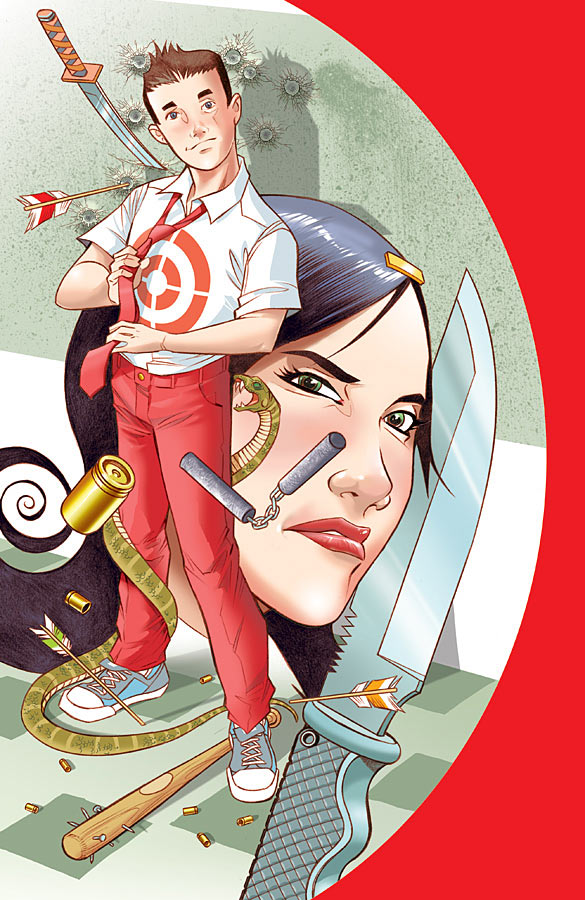
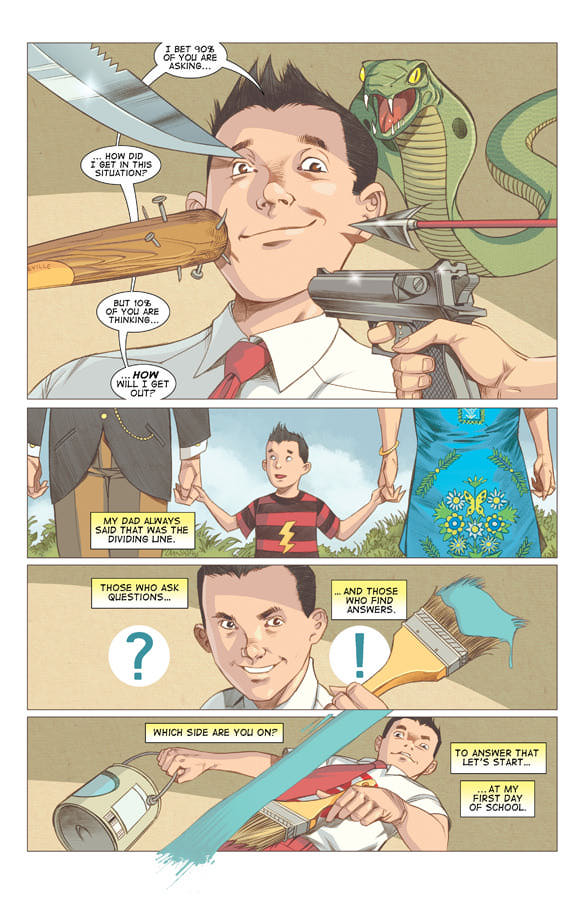
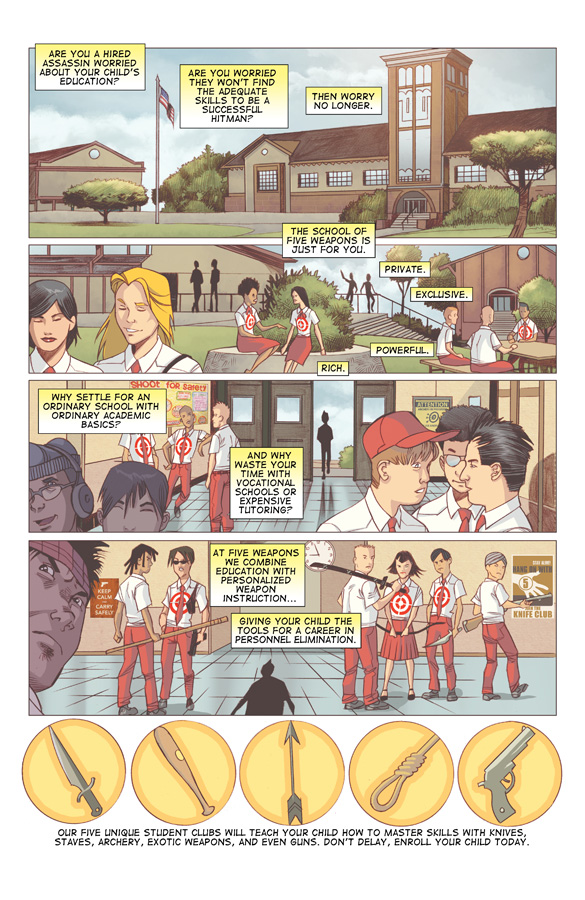
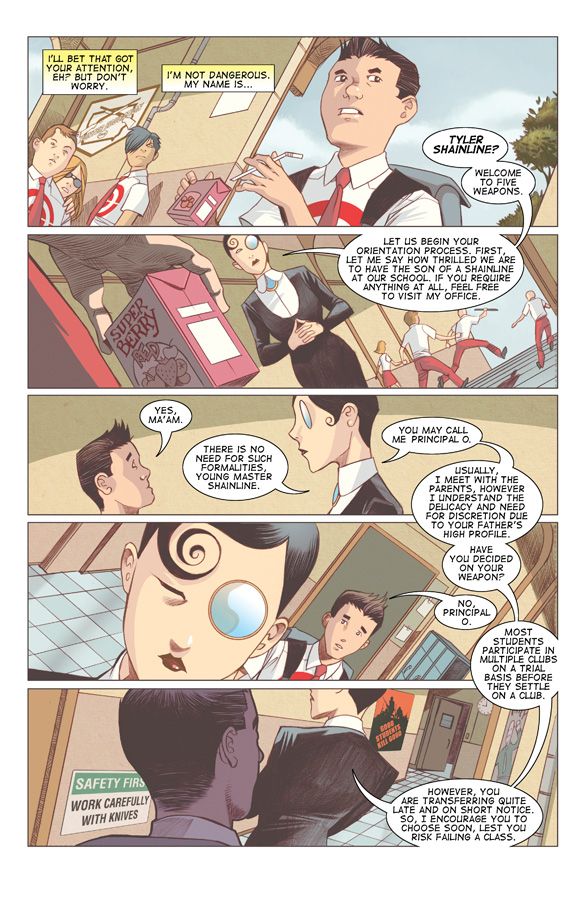
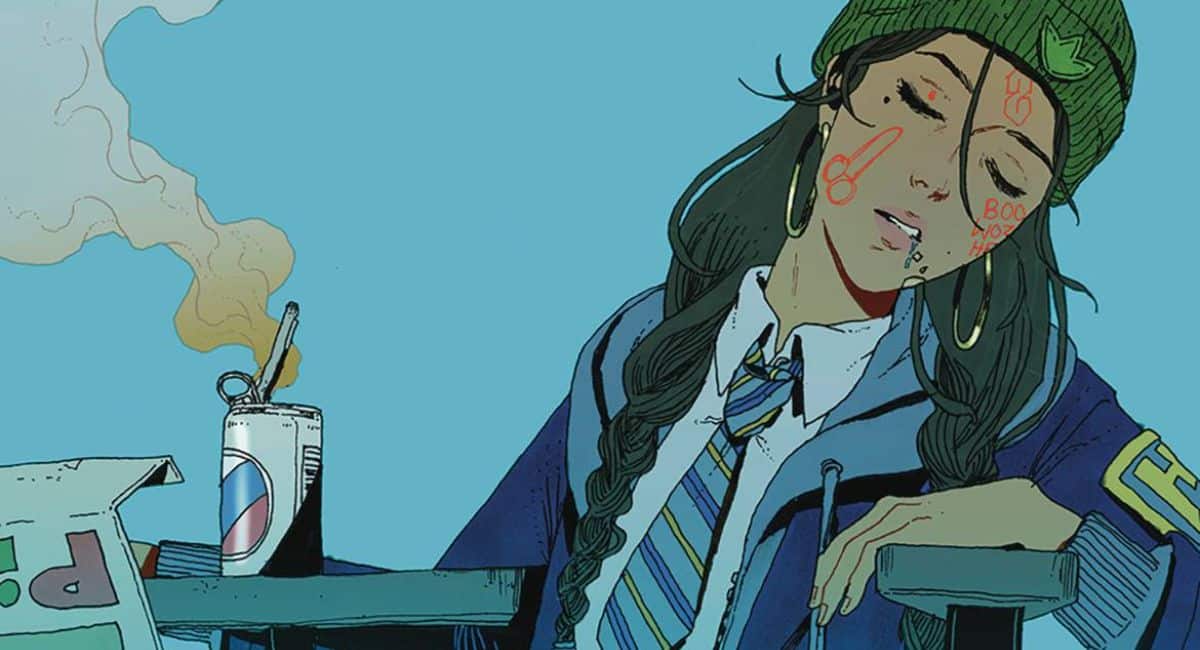




Can you please put a trigger warning for the title. I hate that this site encourages violence against persons of colour.
(Is that an attempt at a joke, xi?)
Jimmie does really solid, creative work, and this series should give people who’ve pigeonholed him because of Bomb Queen reason to think again.
Xi, I really don’t understand what you’re saying. If it’s a joke, I don’t really get it, if it’s serious, um, I don’t really get it…
Funny, I’m not sure what is going on, either.
Nonetheless, I want to thank Steve & The Beat for the excellent questions and the opportunity to talk shop.
One of the things that Jimmie Robinson has always been great at is finding an audience and delivering a great story that appeals to them — without pandering. (Well, maybe Bomb Queen pandered, but that was part of the humor of that series). I’ll seek out this new series from Jimmie!
Comments are closed.